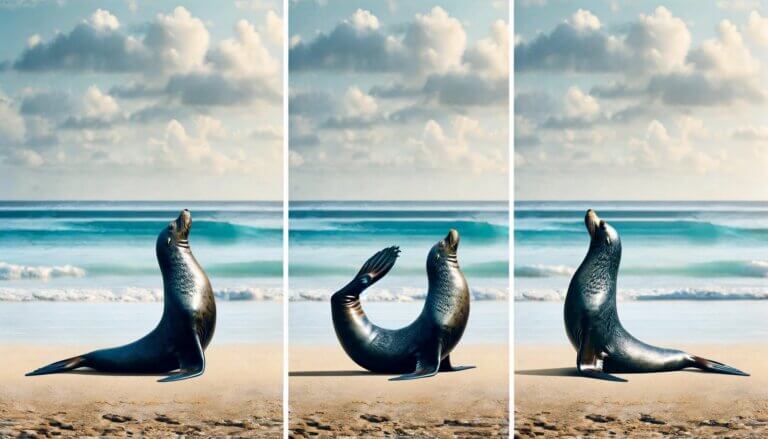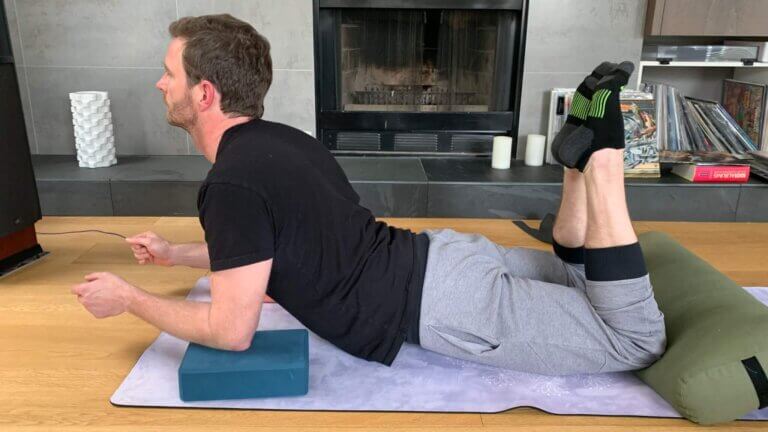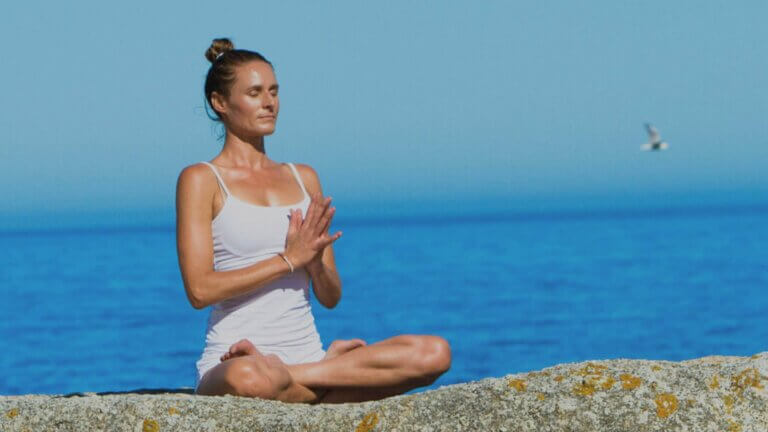Home » Yoga Blog » Yoga Poses » Seal Pose and Sphinx Yoga Salamba Bhujangasana Guide
Seal Pose and Sphinx Yoga Salamba Bhujangasana Guide
The Sphinx Pose, or Salamba Bhujangasana in Sanskrit, is a fundamental yoga posture renowned for its Variations, simplicity and profound benefits. This beginner-level asana is an excellent introduction to backbends and core strengthening exercises in yoga. Its close cousin, Seal Pose in Yin Yoga, offers advanced practitioners a deeper backbend.
In this Yoga Pose Article
Seal and Sphinx Pose: Definition and Background
The Sphinx Pose Salamba Bhujangasana sanskrit name comes from its resemblance to the mythical Sphinx, with its majestic and poised appearance. In Sanskrit, “Salamba” means supported, and “Bhujangasana” refers to a cobra. This pose is a gentler variant of the Cobra Pose (Bhujangasana), making it suitable for beginners or those with back sensitivity.
The seal Yin yoga pose name comes from its animal’s name sake. The pose attempts to imitate a Seal on its front fins upright and proud on the shoreline.

Level of Difficulty
Classified as a beginner pose, it is accessible to most individuals, regardless of their yoga experience. The simplicity of the Sphinx or Seal pose allows practitioners to focus on alignment and breathing without the intensity of more advanced backbends.
Seal and Sphinx Pose Benefits and Purpose
- Spine Health: Gently arching the back helps stretch and strengthen the spine.
- Chest Opening: The pose effectively opens the chest and shoulders, improving lung capacity and aiding in better breathing.
- Stress Reduction: Practicing this pose can lead to relaxation and stress relief, owing to its calming effect on the mind.
- Flexibility and Posture: Regular practice of the Sphinx Pose can enhance flexibility and improve posture, especially for those who spend long hours sitting.
Physical Benefits
- Spine Stretching: Helps in elongating and relieving tension in the spine.
- Back Strengthening: Engages and strengthens the muscles of the lower back.
- Chest Opening: Aids opening the chest and shoulders, enhancing lung capacity.
Mental Benefits
- Stress Reduction: Promotes relaxation, reducing stress levels.
- Anxiety Relief: Calms the mind, helping to alleviate anxiety.
Detailed Guide on How to Sphinx and Seal Pose
How to Do Sphinx Yoga Pose
Starting Position:
- Begin by lying on your stomach.
- Place your forearms flat on the floor, with elbows under the shoulders.
- Keep your legs together and toes pointed.
Movement and Alignment Details:
- Press your forearms and palms onto the floor.
- On an inhale, lift your head and chest, keeping your pelvis and feet grounded.
- Ensure that your elbows remain close to your sides.
- The gaze should be forward or slightly upward, maintaining a neutral neck.
Breath Coordination:
- Coordinate your movements with your breath.
- Inhale as you gently lift into the pose.
- Maintain steady breathing while holding the pose.
- Exhale as you slowly release back to the starting position.

How to Do Seal Yin Yoga Pose
- Follow the step by step instructions for sphinx pose.
- Move your hands toward the right and left sides of the mat.
- Press into your hands, lifting the upper body off the ground and working the arms toward straight.
- While in Seal Yoga Pose use breath coordination to help still the mind
- Remember the Yin Yoga saying in Seal Pose- “Time over intensity in the Posture”
Sphinx and Seal Yoga Pose How to Videos
Common Mistakes and Adjustments
Collapsed Shoulders and Chest:
- Draw the shoulders down and back.
- Actively press the chest forward to prevent rounding of the upper back.
Neck Alignment and Sensitivity:
- Keep the neck long and aligned with the spine.
- Avoid straining the neck; your gaze should be natural and comfortable.
- Place a block or two under the chin if you require extra support.
You Love Yoga, We Love Yoga—Let’s Stay Connected
Get yoga tips, a little inspiration, and friendly emails—because yoga is better with friends.
Sphinx and Seal Pose Variations and Modifications

Modifications for Beginners or Specific Needs:
- Use props such as a cushion or blanket under the pelvis for support.
- Adjust the distance of the elbows from the body to lessen or increase the intensity.
Variations of Seal and Sphinx Pose:
- Supported Sphinx: Use props under the chest or head for additional support. For a deeper Stretch, place a bolster or blocks under the elbows.
- Cobra Pose: Extend your arms in Cobra Pose for those who wish to deepen the backbend.
- Seal Pose: Extend the arms fully, lifting the torso higher off the ground.
- Bend the knees: Bring your feet toward your rear for more compression in the sacrum. Further, you try a Wall Yin Yoga Variation if you need help keeping your feet up

Contraindications and Cautions
When to Avoid Sphinx Pose
Avoid Sphinx Yoga Pose suffering from severe back or neck injuries or for those with recent abdominal surgery.
Adjustments for Pregnancy, Neck Issues, and Back Injuries
- Pregnant women should consult a prenatal yoga instructor for modifications.
- Keep the gaze downward for neck sensitivity, or use a support under the forehead.
- Those with back injuries should practice under the guidance of a qualified yoga instructor and avoid deep backbends.
The Sphinx Pose is a versatile and beneficial asana, with Variations make it suitable for yogis of all levels. Mindful alignment and practice are crucial to maximizing benefits and avoiding strain.
Integration into Practice: Sphinx Yoga Pose (Salamba Bhujangasana)

Preparatory and Follow-Up Poses
Suggested Sequences for Warming Up and Cooling Down:
- Begin with gentle stretches like Child’s Pose or Cat-Cow to warm up the spine.
- After Sphinx Pose, transition to Child’s Pose, Caterpillar Pose (seated forward fold) or a gentle Twist to release any tension in the back.
How Sphinx Pose Fits into Different Yoga Styles:
- In Yin Yoga, the Sphinx and its variation, the Seal Pose, are held for extended periods (2 minutes +) for deep tissue work.
- The pose is a gentle backbend in sequences in Vinyasa or Flow classes.
- Sphinx is also an excellent preparatory pose for more intense backbends in Ashtanga, Anahatasana or Hatha Yoga.
Additional Insights: Meridians and Chakras
Meridians & Organs Affected by Sphinx Pose
Sphinx and Seal Pose in Yin Yoga influences the body’s meridian system, mainly targeting specific meridians and organs. This pose effectively activates the Kidney meridian, which runs along the spine. This activation is significant because the Kidney meridian is closely associated with the body’s reserve of Qi, or life force energy.
By compressing the lower spine and the sacrum, the Sphinx Pose helps open the front of the body, impacting the region of the kidneys and the adrenal glands. This activation is crucial for maintaining the balance of Qi in the body, which is essential for overall health and vitality.
Sphinx Pose also affects and benefits the liver meridian, another crucial aspect of our body’s energy system. The liver supports our well-being by nourishing our blood and directing the flow of Qi throughout the body. It is sensitive to emotions such as frustration and anxiety, so balancing this meridian can help alleviate such emotional states.
Chakras Affected by Sphinx Pose
In terms of chakras, the Sphinx Pose primarily affects the heart chakra. The heart chakra, located in the center of the chest, is associated with love, compassion, and emotional balance.
In Traditional Chinese Medicine (TCM), the heart is called ‘The Emperor,’ signifying its importance as the home for our spirit or consciousness. The heart meridian originates in the heart and spreads throughout the heart system, extending into the diaphragm to connect with its yang counterpart’s small intestine.
By targeting the heart meridian through the Sphinx Pose, you’re likely to benefit the heart, lungs, and large intestine due to the interconnectedness of these meridians.
In summary, practicing the Sphinx Pose in Yin Yoga can have a profound impact on both the meridian system and the chakras, particularly the Kidney and Liver meridians, as well as the heart chakra, contributing to overall physical, emotional, and spiritual balance.
Common Questions About Sphinx Pose
How long should you hold Sphinx Pose
- Aim for 2-6 breaths for beginners, increasing as you get comfortable. Yin Yoga Practitioners start at two minutes and go from there.
What is the difference between Cobra and Sphinx Pose
- Cobra Pose involves straight arms and a deeper backbend, while Sphinx is gentler with forearms on the ground.
Whats the difference between Cobra and Seal Pose
- Cobra Pose hands are under the shoulder and arms bent to straight. Seal Yoga Pose the hands are in front of the shoulder, wider apart than cobra and arms are straight
Can Sphinx Pose help with back pain
- Yes, Sphinx Pose can strengthen the back and alleviate discomfort when practiced correctly.
What's Sphinx Pose Sanskrit Name?
- The Sphinx Pose sanskrit name is Salamba Bhujangasana
Some Final Words
Sphinx and Seal Yoga Pose (Salamba Bhujangasana in sanskrit) and they’re Variations are versatile and accessible asanas with numerous physical and mental benefits. Both poses are an excellent way to introduce backbends into your practice, improve spinal health, and achieve mental relaxation. Whether you’re a beginner or an experienced yogi, incorporating Seal and Sphinx Pose into your routine can enhance your overall yoga experience.
Source Wikipedia


